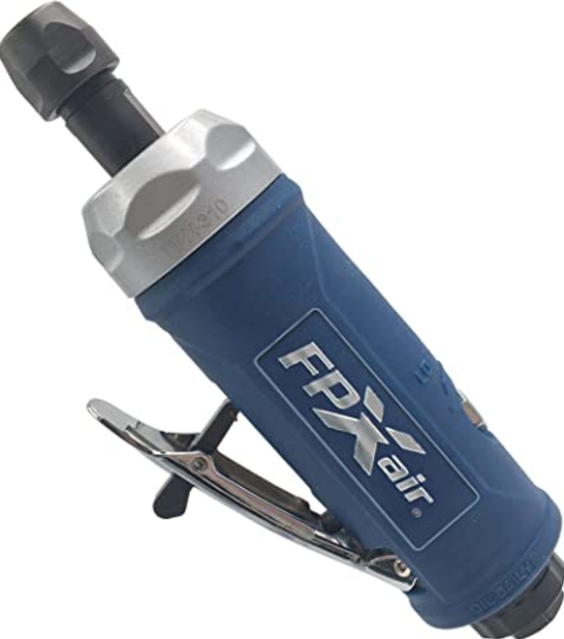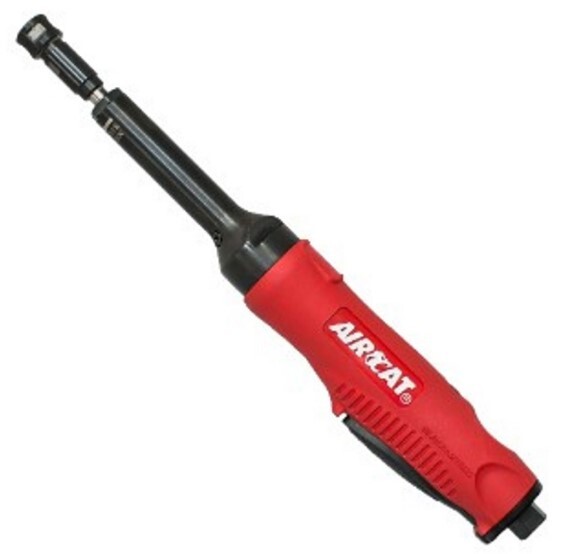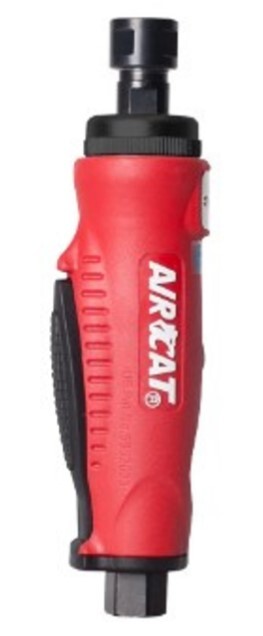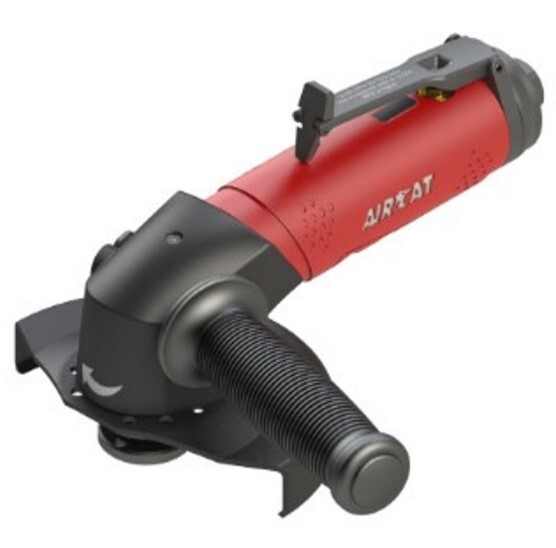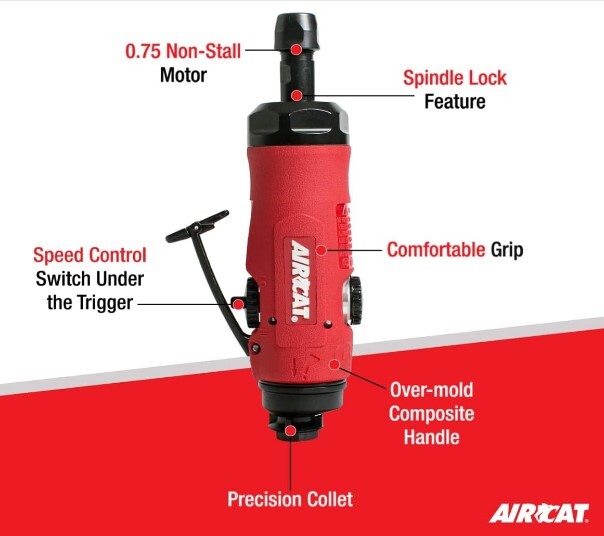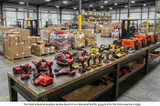The Ultimate Guide to Air Grinders: Understanding Types, Features, and Choosing Your Perfect Pneumatic Partner for 2025
The Ultimate Guide to Air Grinders
Looking for the perfect air grinder to elevate your workshop capabilities in 2025? You're in the right place. Whether you're a professional welder, automotive specialist, or DIY enthusiast, choosing the right air grinder can make or break your project's success. With countless options flooding the market, finding the ideal balance of power, precision, and durability can feel overwhelming. That's why we've meticulously tested and analyzed dozens of air grinders to bring you the top performers. From compact die grinders perfect for tight spaces to heavy-duty angle grinders that tackle the toughest materials, our comprehensive guide covers it all. We'll walk you through essential features like power output (from 3 HP for professional work), speed ranges (7,000-20,000 RPM), and air consumption requirements (4 CFM at 90 PSI). Plus, you'll discover ergonomic designs that ensure comfort during extended use. Let's find your perfect air grinder match.
Key Takeaways
Choosing and using the right air grinder is crucial for precision and efficiency in any workshop. Here's what you need to know for 2025:
-
Diverse Types, Specific Uses: Air grinders come in various forms (die, angle, vertical). Understand that each is designed for specific tasks—die grinders for precision, angle grinders for heavy-duty work. Pick the type that matches your primary application.
-
Power is Paramount: Air grinders are air-hungry! Always match the tool's CFM (Cubic Feet per Minute) and PSI (Pounds per Square Inch) requirements to your air compressor's output. Insufficient air equals poor performance.
-
Features Matter: Pay attention to RPM (Revolutions Per Minute), collet size, and ergonomic design. High RPM is for fine detail, while larger collets accommodate bigger accessories. Ergonomics reduce fatigue during extended use.
-
Safety First, Always: No matter the task, always use full PPE (safety glasses/face shield, ear protection, gloves, respirator). Inspect your tool and accessories before every use.
-
Accessories are Key: The right grinding wheels, burrs, or sanding discs unlock the grinder's full potential. Choose accessories suited to the material and desired finish.
-
Maintenance Extends Life: Regular lubrication with pneumatic tool oil and draining your air compressor's tank are vital for longevity and consistent performance.
By understanding these fundamentals, you'll not only choose the perfect pneumatic partner but also optimize its performance, ensuring precise and efficient work for years to come.
What are Air Grinders and Why Are They Essential?
Air grinders are versatile pneumatic tools that harness compressed air power for various grinding, cutting, and polishing tasks. These essential workshop companions offer superior control and precision compared to their electric counterparts, making them indispensable for a wide array of applications.
The Unmatched Advantages of Air Grinders
Air grinders excel in delivering consistent power output without the risk of overheating, a common issue with electric tools during prolonged use. Their reliance on compressed air makes them inherently safer in environments where electrical tools might pose spark hazards or short-circuit risks, such as in wet conditions or around flammable materials. The absence of a bulky internal motor contributes to their remarkably lightweight design, significantly enhancing maneuverability and reducing user fatigue during extended operation. This consistent power delivery, coupled with their lighter weight, allows for more precise control, leading to superior finish quality and reduced material waste.
Core Components of Air Grinders
Understanding the fundamental components of an air grinder helps appreciate its operational efficiency and precision. Each part plays a crucial role in the tool's overall performance:
- Compressed Air Inlet: This is where the air hose connects, delivering pressurized air from the compressor to the tool. A clean and properly regulated air supply is vital for optimal performance and tool longevity.
- Speed Control Mechanism: Often a throttle or lever, this mechanism allows the user to regulate the rotational speed of the grinding attachment. Variable speed control is crucial for adapting to different materials and tasks, from aggressive material removal to delicate finishing.
- Collet or Chuck System: This component securely holds the grinding wheel, burr, or other attachment. Collets come in various sizes (e.g., , 1/8′′) to accommodate different shank diameters of accessories. A precise and robust collet ensures minimal runout and maximum safety.
- Ergonomic Grip Handle: Designed for comfort and control, the handle often features rubberized or textured surfaces to provide a secure grip, even with oily hands. Advanced designs incorporate vibration-dampening materials to reduce user fatigue and the risk of hand-arm vibration syndrome (HAVS).
- Exhaust Port: This is where the spent compressed air is expelled from the tool. Many modern air grinders feature rear exhaust systems to direct air away from the workpiece and the operator, reducing noise and preventing debris from being blown into the user's face.
- Safety Trigger Mechanism: A critical safety feature, this mechanism often requires a deliberate action (e.g., a two-stage trigger or a paddle switch) to prevent accidental starts. Some models include a lock-off feature for added security when the tool is not in use.
These elements work in concert to ensure smooth, powerful, and precise operation across a wide range of applications.
Common Applications Across Industries
Air grinders are incredibly versatile, finding extensive use across multiple industries and for countless tasks. Their adaptability makes them indispensable for both professional craftsmen and dedicated DIY enthusiasts who demand reliability and precision in their work.
- Automotive Repair and Restoration: Essential for grinding down welds, removing rust, porting cylinder heads, cleaning engine components, and preparing surfaces for painting.
- Metal Fabrication and Welding: Used for deburring sharp edges, grinding down weld beads, shaping metal, chamfering, and preparing surfaces for further processing.
- Woodworking and Carpentry: While less common than for metal, mini die grinders can be used for detailed carving, sanding intricate shapes, and smoothing small areas.
- Industrial Manufacturing: Crucial for mold and die grinding, deburring machined parts, finishing castings, and preparing surfaces in assembly lines.
- Construction and Renovation: Heavy-duty angle grinders are vital for cutting rebar, grinding concrete, tuckpointing mortar joints, and preparing surfaces for tiling or flooring.
- Art and Sculpture: Precision die grinders are favored by artists for shaping, carving, and detailing in various materials like stone, metal, and wood.
Key Benefits of Choosing Air Grinders
Beyond their core functionality, air grinders offer a suite of benefits that make them a preferred choice for many professionals:
- Consistent Power Delivery: Unlike electric tools that can bog down under heavy loads, air grinders maintain consistent RPM, ensuring uniform material removal and a smoother finish.
- Lower Maintenance Requirements: With fewer moving parts and no internal motor windings to burn out, air grinders typically require less maintenance than their electric counterparts, primarily focusing on lubrication and air quality.
- Extended Tool Life: Their robust construction and efficient heat dissipation (due to continuous airflow) contribute to a significantly longer operational lifespan, even under demanding conditions.
- Better Heat Management: The continuous flow of compressed air through the tool helps dissipate heat, preventing overheating and extending the life of both the tool and the abrasive.
- Enhanced Safety Features: Designed with safety in mind, many air grinders incorporate features like paddle-style switches, lock-off triggers, and protective guards to minimize accidents.
- Superior Control and Precision: Their lightweight nature and ergonomic design allow for finer control, which is critical for intricate work and achieving high-quality finishes.
Key takeaway: Air grinders are versatile pneumatic tools that offer consistent power, precise control, and enhanced safety features, making them essential for various industrial and DIY applications.
Decoding the Different Types of Air Grinders
Air grinders come in several distinct varieties, each meticulously designed for specific applications and working conditions. Understanding these types is crucial for selecting the tool that best fits your project needs.
Straight Air Die Grinders
These compact and powerful tools feature a straight, inline design, making them ideal for precision work in tight spaces, intricate detailing, and reaching into confined areas. They are often the go-to choice for:
- Deburring: Removing sharp edges and burrs from machined or cut metal parts.
- Polishing: Achieving a smooth, mirror-like finish on various surfaces using appropriate polishing accessories.
- Detail Grinding: Shaping and refining small components, molds, and dies.
- Porting: Widely used in automotive performance tuning for smoothing and enlarging intake and exhaust ports on cylinder heads.
They typically operate at high speeds, often between 20,000−25,000 RPM, and commonly use 1/4′′ or 1/8′′ collets.
Angle Air Grinders
Featuring a head angled at 90 degrees to the main body, angle air grinders are incredibly versatile, excelling at working on vertical surfaces, hard-to-reach angles, and for tasks requiring a different approach angle. They are commonly used for:
- Weld Grinding: Smoothing down and finishing weld beads.
- Surface Preparation: Removing paint, rust, and scale from large surfaces before coating or finishing.
- Cutting Operations: Using cut-off wheels to slice through metal, bolts, and other materials.
- Chamfering: Creating beveled edges on workpieces.
Angle grinders are available in various disc sizes, from 2′′ mini-grinders to 7′′ or 9′′ heavy-duty models, with corresponding RPMs that are generally lower than die grinders, typically ranging from 7,000−15,000 RPM.
Extended Air Die Grinders
As their name suggests, these tools have a longer shaft compared to standard straight die grinders, allowing them to reach deep into cavities, around obstacles, or into areas inaccessible by shorter tools. They are particularly useful in:
- Automotive Repair: Reaching into engine bays, chassis components, or exhaust systems for grinding, deburring, or cleaning.
- Manufacturing Processes: Accessing internal surfaces of pipes, castings, or complex machinery.
- Mold and Die Work: For deep-seated grinding or polishing within large molds.
Their extended reach enhances versatility without sacrificing precision, often maintaining similar RPM ranges to straight die grinders.
Mini Air Grinders
Compact and exceptionally lightweight, mini air grinders are designed for intricate work, fine detailing, and precision finishing where larger tools would be cumbersome. Their small size and high RPMs make them perfect for:
- Jewelry Making: Polishing, shaping, and engraving delicate pieces.
- Model Building: Refining small components and intricate details.
- Fine Metalwork: Creating detailed textures or removing minute imperfections.
- Engraving: Used with specialized burrs for precise engraving on various materials.
These tools are often palm-sized and operate at very high speeds, sometimes exceeding 25,000 RPM, typically using 1/8′′ collets.
Heavy-Duty Air Grinders
Built for demanding industrial applications and continuous operation, these robust tools are designed to tackle the toughest materials and withstand prolonged, rigorous use. They feature reinforced components, higher power outputs, and often larger disc capacities. Their primary uses include:
- Large-Scale Material Removal: Aggressive grinding of thick welds, large castings, or heavy metal stock.
- Industrial Fabrication: Continuous use in manufacturing plants, shipyards, and foundries.
- Construction: Cutting and grinding concrete, rebar, and structural steel.
Heavy-duty models boast higher horsepower (2.0−3.0 HP) and are built for durability, often with larger air consumption requirements to sustain their power.
Key takeaway: Air grinders come in five main types - straight, angle, extended, mini, and heavy-duty - each optimized for specific applications and working conditions.
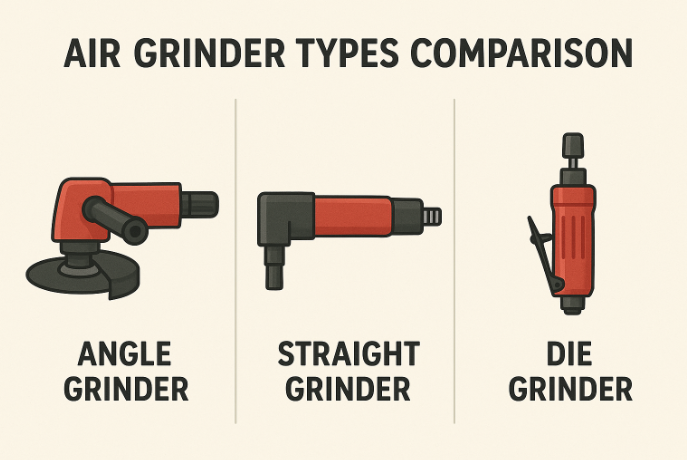
|
Air Grinder Type |
Best Use Case |
Typical RPM Range (approx.) |
Common Collet/Disc Size |
Key Advantage |
|
Straight Die Grinder |
Precision deburring, polishing, intricate grinding |
20,000−25,000 |
1/4′′, 1/8′′ |
Excellent for tight spaces and fine detail |
|
Angle Grinder |
Weld grinding, surface prep, cutting, vertical work |
7,000−15,000 |
2′′−9′′ discs |
Versatile for various angles and heavy work |
|
Extended Die Grinder |
Reaching deep cavities, around obstacles |
20,000−25,000 |
1/4′′, 1/8′′ |
Unmatched access in confined or deep areas |
|
Mini Grinder |
Intricate detail work, jewelry, model building |
25,000+ |
1/8′′ |
Ultra-compact for delicate, precise tasks |
|
Heavy-Duty Grinder |
Continuous industrial use, large material removal |
7,000−12,000 |
4′′−9′′ discs |
Robust, powerful, built for demanding jobs |
Essential Features for Optimal Performance and Comfort
When selecting an air grinder, several crucial features demand your attention to ensure you get the most suitable tool for your needs. These aspects can significantly impact your working experience, productivity, and the quality of your results.
Ergonomic Design and Comfort
A well-designed air grinder should fit comfortably and securely in your hand, even during extended periods of use. Ergonomics are not just about comfort; they directly influence control, precision, and safety. Look for tools with:
- Rubberized Grips: Provide a non-slip surface, absorb vibrations, and offer a more comfortable hold.
- Vibration-Reduction Technology: Internal dampeners or specialized handle designs that minimize the transfer of tool vibrations to the user's hand, reducing fatigue and preventing long-term health issues like HAVS.
- Balanced Weight Distribution: A tool that feels balanced in your hand, with its center of gravity close to the grip, reduces strain and allows for better maneuverability, especially during intricate or overhead work.
- Compact and Lightweight Profile: While power is important, a lighter tool (typically 1.5 to 3 pounds for most die grinders) significantly reduces fatigue during prolonged tasks.
The ergonomic design helps prevent hand fatigue and ensures better control over the tool, especially during precision work.
Build Quality and Durability
The build quality directly influences the tool's longevity, reliability, and consistent performance over time. Investing in a tool with superior construction materials and manufacturing processes pays dividends in the long run. Premium air grinders typically feature:
- Aircraft-Grade Aluminum Housing: Provides a strong yet lightweight exterior that resists corrosion and impact damage.
- Heat-Treated Steel Components: Critical internal parts like gears, spindles, and collets are heat-treated for enhanced hardness, wear resistance, and durability.
- Sealed Ball Bearings: Protect internal mechanisms from dust and debris, ensuring smoother operation, reducing friction, and extending the lifespan of rotating parts.
- Reinforced Motor Housing: Protects the air motor from external impacts and internal stresses, ensuring consistent power delivery.
- Precision Machining: Tightly toleranced components reduce vibration, improve efficiency, and enhance overall tool precision.
Noise Level and Operation
While all pneumatic tools generate some noise, modern air grinders prioritize quieter operation without compromising power. Prolonged exposure to high noise levels can lead to hearing damage, so choosing a quieter model is a significant health benefit. The best models aim to maintain noise levels below 85 decibels (dB), which is the threshold for mandatory hearing protection in many workplaces. Features that contribute to reduced noise include:
- Sound-Dampening Materials: Internal baffling and composite housings designed to absorb and reduce operational noise.
- Rear Exhaust Systems: Direct the expelled air away from the operator and the workpiece, which can significantly reduce perceived noise levels and prevent debris from being blown around.
- Advanced Motor Design: Optimized air passages and rotor designs can reduce internal turbulence and associated noise.
Speed Control and Precision
Variable speed control is a crucial feature that allows you to match the tool's rotational speed (RPM) to your specific task and the material you're working on. This adaptability prevents overheating, burning, or damaging the workpiece, and allows for optimal abrasive performance. Look for models offering:
- Multiple Speed Settings: Pre-set speeds or a wide range of continuous adjustment.
- Speed Governor for Consistent RPM: An internal mechanism that automatically adjusts air flow to maintain a set RPM, even under varying loads, ensuring uniform material removal.
- Quick Response Throttle: Allows for immediate and precise control over the tool's speed, crucial for delicate work.
- Precision Control Mechanism: A tactile and responsive trigger or lever that gives the user fine-tuned control over the tool's power.
Air Consumption Efficiency
The tool's air consumption rate, measured in CFM (Cubic Feet per Minute) at a specific PSI (Pounds per Square Inch), affects both performance and operating costs. An efficient model minimizes the strain on your air compressor and reduces electricity consumption. Efficient models typically require:
- 4-6 CFM at 90 PSI for Optimal Performance: This is a common benchmark for many general-purpose air grinders.
- Balanced Air Consumption: The tool uses air efficiently, converting it effectively into rotational power.
- Proper Pressure Regulation: The ability to operate consistently at the recommended pressure (usually 90 PSI) is vital. Too low pressure reduces power; too high pressure can damage the tool.
- Minimal Air Leakage: High-quality seals and construction prevent air from escaping, ensuring all compressed air contributes to performance.
Power Requirements and Performance
Air grinders require specific power specifications to deliver optimal performance. The interplay of PSI, CFM, and Horsepower (HP) determines the tool's ability to tackle various tasks effectively.
- Operating Pressure (PSI): Most professional-grade air grinders are designed to operate optimally at 90 PSI. Maintaining this pressure at the tool is critical for consistent power and speed.
- Speed Range (RPM): The speed capabilities typically range from 7,000 RPM for heavy-duty angle grinders to 25,000+ RPM for precision die grinders. Higher speeds are generally ideal for rapid material removal and smaller abrasive tools, while lower speeds offer better control for detailed work and larger grinding wheels.
- Air Consumption (CFM): This indicates how much air the tool consumes. Your air compressor's output (SCFM - Standard Cubic Feet per Minute) must meet or exceed the grinder's CFM requirement to prevent performance degradation.
- Minimum 4 CFM at 90 PSI for light-duty tools (e.g., mini die grinders).
- 5−6 CFM at 90 PSI for medium-duty applications (e.g., general-purpose die grinders).
- 7+ CFM at 90 PSI for heavy-duty industrial use (e.g., large angle grinders).
- Power Output (HP): Measured in horsepower, this indicates the tool's raw power.
- 0.5−1.0 HP for detail work and finishing.
- 1.0−2.0 HP for general-purpose grinding and cutting.
- 2.0−3.0 HP for heavy-duty material removal and industrial applications.
The power output directly impacts the tool's ability to maintain consistent speed under load, which is crucial for achieving high precision results in demanding applications. A higher HP rating generally means the tool can cut or grind more aggressively without stalling.
Key takeaway: Air grinders typically require 90 PSI operating pressure and 4−6 CFM air consumption, with speed ranges from 7,000−25,000 RPM for optimal performance across various applications.
Frequently Asked Questions (FAQ)
What is an air grinder? An air grinder, also known as a pneumatic grinder, is a power tool that utilizes compressed air to rapidly rotate an abrasive attachment.
How do air grinders differ from electric grinders? The primary distinction lies in their power source. Air grinders operate on compressed air (pneumatic power) and thus require an air compressor, whereas electric grinders are powered by electricity (either corded or battery-operated).
What are the different types of air grinders? Common classifications of air grinders include:
-
Die Grinders: These are smaller, straight-bodied tools specifically designed for precision work, intricate shaping, deburring, and accessing confined spaces.
-
Angle Grinders (Pneumatic):
Similar in function to their electric counterparts, these feature a head angled at 90 degrees and are employed for heavier cutting, grinding, and broad surface preparation. -
Vertical Grinders: These robust tools are engineered for aggressive grinding and sanding tasks on large, flat surfaces.
What kind of air compressor do I need for an air grinder? Air grinders are known for their high CFM (Cubic Feet per Minute) demand. To ensure continuous and powerful operation, your air compressor must be capable of supplying the specified CFM at the required PSI (Pounds per Square Inch) of the grinder.
What are common applications for air grinders? Their versatility makes air grinders suitable for numerous applications, including:
-
Metal Fabrication: Grinding down welds, cutting metal sheets, shaping components, and deburring edges.
-
Automotive Repair: Porting engine heads, polishing components, removing rust, and general engine cleaning.
-
Woodworking: Intricate shaping, carving, and sanding detailed wooden pieces.
-
Finishing Work: Achieving smooth finishes, removing imperfections, and adding detailed touches.
-
Mold & Die Work: Performing precision grinding and polishing on intricate molds and dies.
What safety precautions should I take when using an air grinder? Operating any power tool requires strict adherence to safety protocols. Always:
-
Wear appropriate Personal Protective Equipment (PPE), which includes safety glasses or a full face shield, hearing protection (earmuffs or earplugs), sturdy gloves, and a dust mask or respirator.
-
Disconnect the tool from the air supply before changing attachments, making adjustments, or performing any maintenance.
-
Ensure you use the correct abrasive attachment that is rated for the material and task at hand.
-
Inspect both the tool and its attachments for any signs of damage before each use.
-
Maintain a stable stance and a firm, controlled grip on the tool during operation.
-
Never exceed the maximum RPM (revolutions per minute) rating of the abrasive attachment being used.
How do I maintain an air grinder? Regular and proper maintenance is key to extending the life and ensuring the optimal performance of your air grinder:
-
Lubricate the tool regularly with pneumatic tool oil, following the manufacturer's specific instructions (often daily or before each use).
-
Drain your air compressor's tank daily to prevent moisture from building up and entering your air lines, which can damage the grinder.
-
Utilize an air filter/regulator/lubricator (FRL) unit in your air line system to provide clean, dry, and consistently lubricated air to the tool.
-
Regularly check all air hoses and fittings for any signs of leaks, kinks, or damage.
-
Inspect and replace worn or damaged abrasive attachments promptly to maintain efficiency and safety.
Related Articles:
Die Grinders vs. Angle Grinders: A Complete Guide to Choosing the Right Power Tool
Mastering Precision: A Deep Dive into Die Grinders for Intricate Metalwork and Finishing
The Essential Guide to Air Grinders: Types, Features, and Power Fundamentals
15 Essential Pneumatic Tools Every Workshop Must Have
Mastering Air Grinder Selection & Usage: Top Picks, Applications, Safety, and Accessories
Conclusion
Ultimately, mastering the world of air grinders in 2025 comes down to informed choice. By understanding the distinct types available, recognizing their crucial features, and ensuring you meet their fundamental power requirements, you're equipped to select more than just a tool, you're choosing your perfect pneumatic partner. Embrace this knowledge, prioritize safety, and leverage the right accessories, and your air grinder will consistently deliver the precision, power, and efficiency needed to elevate your craftsmanship and achieve exceptional results on every project.
You've explored the ultimate guide to air grinders, understanding their types, features, and how to choose your perfect pneumatic partner. Now it's time to equip your workshop with top-tier tools that deliver precision and power.
Looking to purchase an air grinder or need expert advice tailored to your specific needs? Tend Industrial Supplies is your trusted source for high-quality air grinders and accessories, along with the expertise to guide your selection.
Email us at sales@tendsupplies.com or visit tendsupplies.com to browse our extensive selection and get the perfect pneumatic partner for your tasks.



